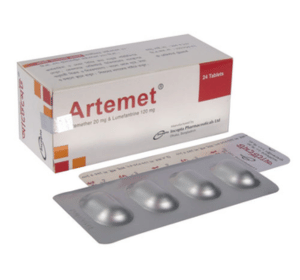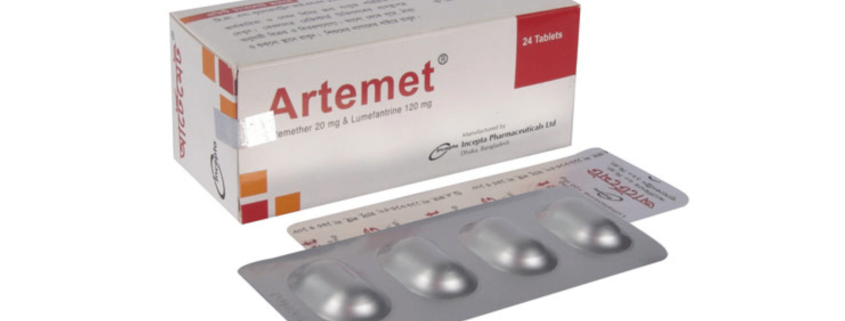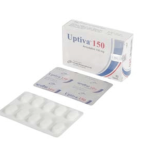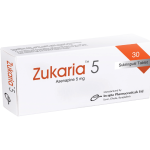Artemet(Artemether & Lumefantrine)

Therapeutic Group: Anti Protozoal
Presentation
Artemet: Each tablet contains Artemether INN 20 mg and Lumefantrine INN 120 mg.
Description
This formulation contains a fixed ratio of 1 : 6 parts of Artemether and Lumefantrine. The site of antiparasitic action of both components is the food vacuole of the malarial parasite, where they are thought to interfere with the conversion of haem, a toxic intermediate produced during haemoglobin breakdown, to the non-toxic haemozoin (malaria pigment). Lumefantrine is thought to interfere with the polymerisation process, while Artemether generates reactive metabolites as a result of the interaction between its peroxide bridge and haem iron. Both Artemether and Lumefantrine have a secondary action involving inhibition of nucleic acid and protein synthesis within the malarial parasite.
Indications
Artemether-Lumefantrine is indicated in the treatment of adults, children and infants with acute, uncomplicated infections due to Plasmodium falciparum or mixed infections including P. falciparum. Because this combination is effective against both drug-sensitive and drug-resistant P. falciparum, it is also recommended for malaria infections acquired in areas where the parasites may be resistant to other antimalarials.
Stand-by emergency treatment: Prescribers are advised to issue Artemether-Lumefantrine combination (to be carried for self-administration) to those tourists and business travelers who are considered to be non-immune and may be unable to obtain medical care within 24 hours of the onset of symptoms of malaria.
Dosage & Administration
The treatment should be administered at the time of initial diagnosis or at onset of symptoms. This combination should be taken with food or drinks rich in fat (such as milk). The treatment schedule is as follows:
| Patient Type | Frist day | Second day | Third day |
|---|---|---|---|
| Children (weighing 5 kg to less than 15 kg) | 1 tablet at the time of initial diagnosis, 1 tablet again after 8 hours | 1 tablet twice daily (morning and evening) | 1 tablet twice daily (morning and evening) |
| Children (weighing 15 kg to less than 25 kg and 12 years of age or less) | 2 tablets as a single dose at the time of initial diagnosis, 2 tablets again after 8 hours | 2 tablets twice daily (morning and evening) | 2 tablets twice daily (morning and evening) |
| Children (weighing 25 kg to less than 35 kg and 12 years of age or less) | 3 tablets as a single dose at the time of initial diagnosis, 3 tablets again after 8 hours | 3 tablets twice daily (morning and evening) | 3 tablets twice daily (morning and evening) |
| Adults and children (weighing 35 kg and above or more than 12 years of age) | 4 tablets as a single dose at the time of initial diagnosis, 4 tablets again after 8 hours | 4 tablets twice daily (morning and evening) | 4 tablets twice daily (morning and evening) |
Side Effects
This formulation is generally well tolerated. However, few side effects such as anorexia, headache, dizziness, sleep disorder, palpitation, pruritus, rash, abdominal pain, nausea and vomiting have been reported.
Precautions
If a patient deteriorates whilst taking this combination, alternative treatment for malaria should be started without delay. The long elimination half-life of Lumefantrine must be taken into account when administering quinine in patients previously treated with this combination. This combination has not been evaluated for: prophylaxis; treatment of cerebral malaria; treatment of severe malaria including pulmonary oedema or renal failure; treatment of malaria due to P. vivax, P. malariae or P. ovale.
Use in Pregnancy & Lactation
Pregnancy: Based on animal data, this combination is suspected to cause serious birth defects during the first trimester of pregnancy. Artemether has demonstrated teratogenic potential with an increased risk during early gestation. This combination is contraindicated during the first trimester of pregnancy. During the second and the third trimester, treatment should only be considered if the expected benefit to the mother outweighs the risk to the foetus.
Lactation: Breast-feeding women should not take Artemether-Lumefantrine combination.
Drug Interaction
Dose adjustment of Artemether-Lumefantrine is considered unnecessary when administered in association with ketoconazole. The likelihood of interactions with other drugs is minimal in view of its short duration of administration and wide therapeutic index. From study it was found that, the risk of QTc-prolongation associated with IV quinine was enhanced by prior administration of this combination.
Over Dose
In cases of suspected overdosage, symptomatic and supportive therapy should be given as appropriate. ECG and electrolytes (e.g. potassium) should be monitored.
Commercial Pack
Artemet: Each box contains 6 Alu-Alu blister strip of 4 tablets.



